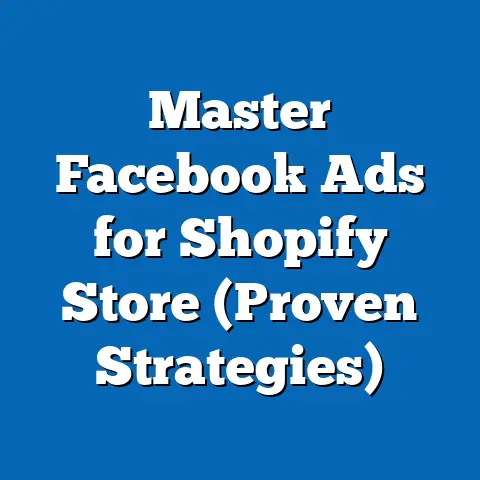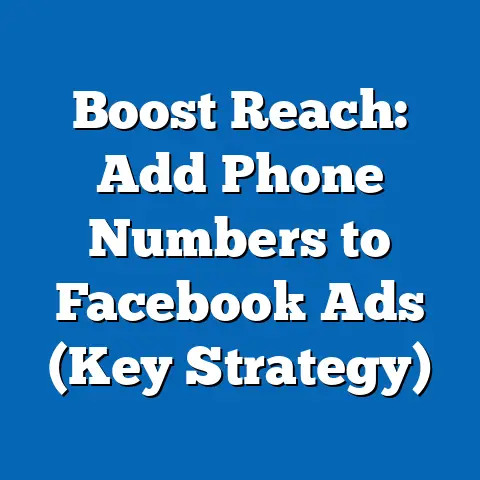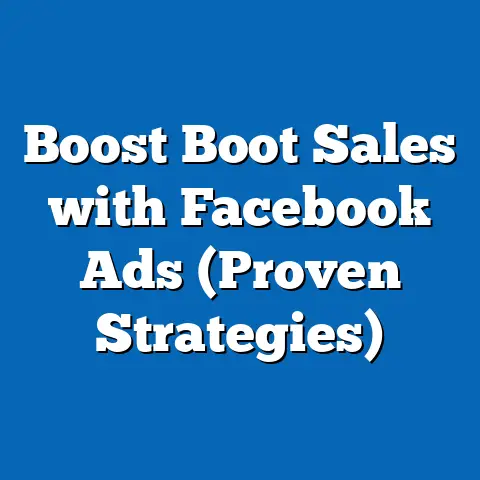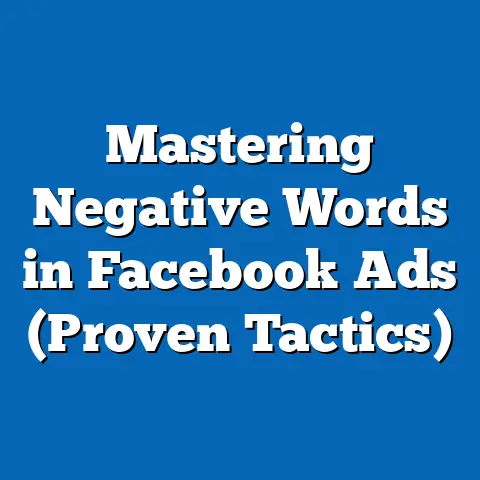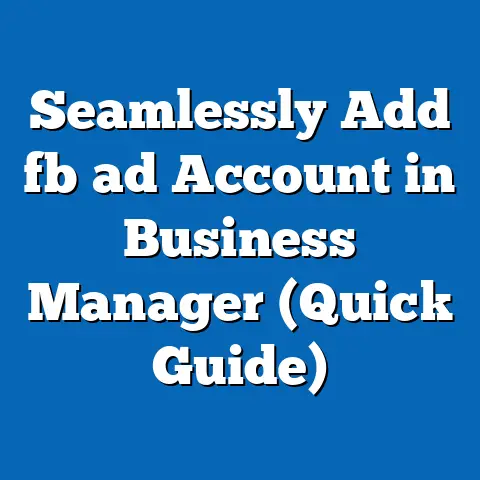How to Fix a Facebook Ad Mistake (Expert Recovery Guide)
In the realm of luxury brands, perception is everything. Every image, every word, every interaction contributes to the carefully crafted aura of exclusivity and desirability. Facebook ads, when executed flawlessly, can be a powerful tool for reaching affluent consumers and building brand loyalty. However, a single misstep in the digital landscape can have significant repercussions, potentially tarnishing the brand’s image and impacting sales.
I’ve witnessed firsthand the delicate balance luxury brands must maintain on social media. One wrong move, a poorly targeted ad, or a message that doesn’t resonate with the discerning tastes of their audience, and the consequences can be far-reaching. This isn’t just about losing a few clicks; it’s about potentially damaging the brand’s prestige and alienating valuable customers.
This guide is designed to provide luxury brands with a comprehensive roadmap for recovering from Facebook ad mistakes. It will equip you with the knowledge and strategies needed to navigate the complexities of social media advertising, minimize the impact of errors, and transform them into opportunities for growth and refinement. Let’s dive in and explore how to turn a potential crisis into a testament to your brand’s resilience and commitment to excellence.
Understanding Common Facebook Ad Mistakes in the Luxury Niche
Luxury brands operate in a unique advertising ecosystem. What works for mass-market products often falls flat, or worse, backfires when applied to high-end goods and services. The common mistakes I see luxury brands making on Facebook often stem from a misunderstanding of this fundamental difference.
Here are some of the most frequent pitfalls I’ve observed:
- Untargeted or Broad Targeting: Luxury isn’t for everyone. Casting too wide a net dilutes the brand’s exclusivity. I’ve seen brands waste significant budget targeting individuals who simply can’t afford their products or services, leading to low engagement and a negative ROI.
- Poor Visual Quality: In the luxury world, aesthetics are paramount. Blurry images, amateur videos, or inconsistent branding are a death knell. I remember a campaign for a high-end watch brand that used poorly lit product photos – it screamed “cheap imitation” and did more harm than good.
- Generic Messaging: Luxury consumers aren’t swayed by generic sales pitches. They seek experiences, stories, and a connection to the brand’s heritage. Ads that simply list features and prices fail to capture their attention. I always advise my clients to focus on the “why” behind their products, not just the “what.”
- Ignoring Platform Nuances: What works on Instagram might not work on Facebook. Each platform has its own unique audience and expectations. Failing to tailor your message to the specific platform can result in low engagement and wasted ad spend.
- Lack of Mobile Optimization: A significant portion of Facebook users access the platform on their mobile devices. Ads that aren’t optimized for mobile viewing (e.g., slow loading times, small text) create a frustrating user experience.
- Not Monitoring and Adjusting: Setting up an ad and forgetting about it is a recipe for disaster. Luxury brands need to actively monitor their campaigns, analyze the data, and make adjustments as needed to optimize performance.
These mistakes can have a cascading effect. They can lead to:
- Reduced Brand Perception: A poorly executed ad can damage the brand’s image and erode trust with potential customers.
- Decreased Sales: Ineffective ads translate to fewer leads, fewer conversions, and ultimately, lower revenue.
- Wasted Ad Spend: Every dollar spent on a poorly performing ad is a dollar lost. For luxury brands, this can be a significant amount of money.
- Negative Word-of-Mouth: In the age of social media, negative experiences spread quickly. A bad ad can generate negative comments, reviews, and ultimately, damage the brand’s reputation.
Consider the case of a luxury fashion house that ran a Facebook ad campaign featuring overly aggressive sales language. The ad was perceived as “tacky” and “out of character” by their target audience, leading to a barrage of negative comments and a public apology from the brand. This highlights the importance of maintaining brand integrity even when advertising on social media.
Key Takeaway: Understanding the unique nuances of the luxury market and avoiding common pitfalls is crucial for successful Facebook advertising.
First Steps to Recovery
So, you’ve identified a mistake in your Facebook ad campaign. What do you do next? The immediate aftermath is crucial. The way you respond can either mitigate the damage or exacerbate the situation.
The first and most important step is to pause the offending ad immediately. Don’t let it continue to run and potentially cause further harm. Once the ad is paused, take a deep breath and resist the urge to panic. A calm and strategic approach is essential.
Next, assess the damage. This involves gathering data to understand the impact of the mistake. Here’s what you should be looking at:
-
Key Performance Indicators (KPIs):
- Click-Through Rate (CTR): Is it significantly lower than your average CTR?
- Engagement Rate: Are people interacting with the ad (likes, comments, shares)? Is the sentiment positive or negative?
- Cost Per Click (CPC): Is it higher than usual?
- Cost Per Acquisition (CPA): Are you acquiring customers at an acceptable cost?
- Reach and Frequency: How many people have seen the ad, and how often?
-
Audience Feedback:
- Comments: Read through the comments on the ad to understand how people are reacting to it.
- Private Messages: Check your Facebook page’s inbox for any messages related to the ad.
- Mentions: Monitor social media for mentions of your brand and the ad.
-
Website Analytics:
- Traffic: Has there been a noticeable increase or decrease in traffic to your website from Facebook?
- Bounce Rate: Are people leaving your website immediately after clicking on the ad?
- Conversion Rate: Are people converting (e.g., making a purchase, filling out a form) after clicking on the ad?
Key Performance Indicators (KPIs):
- Click-Through Rate (CTR): Is it significantly lower than your average CTR?
- Engagement Rate: Are people interacting with the ad (likes, comments, shares)? Is the sentiment positive or negative?
- Cost Per Click (CPC): Is it higher than usual?
- Cost Per Acquisition (CPA): Are you acquiring customers at an acceptable cost?
- Reach and Frequency: How many people have seen the ad, and how often?
Audience Feedback:
- Comments: Read through the comments on the ad to understand how people are reacting to it.
- Private Messages: Check your Facebook page’s inbox for any messages related to the ad.
- Mentions: Monitor social media for mentions of your brand and the ad.
Website Analytics:
- Traffic: Has there been a noticeable increase or decrease in traffic to your website from Facebook?
- Bounce Rate: Are people leaving your website immediately after clicking on the ad?
- Conversion Rate: Are people converting (e.g., making a purchase, filling out a form) after clicking on the ad?
By analyzing these metrics, you can get a clear picture of the mistake’s impact and identify the areas that need immediate attention.
Important Tip: Don’t rely solely on quantitative data. Qualitative feedback from comments and messages can provide valuable insights into the emotional impact of the ad.
Once you’ve gathered the data, document your findings. This will be helpful when you’re crafting your recovery strategy.
Finally, communicate internally. Inform your marketing team, public relations team, and any other relevant stakeholders about the situation. Transparency and collaboration are essential for a successful recovery.
Key Takeaway: Pausing the ad, assessing the damage, and communicating internally are the crucial first steps in recovering from a Facebook ad mistake.
Analyzing the Mistake
With the immediate crisis under control, it’s time to delve deeper and understand exactly why the ad failed. This involves a thorough analysis of all aspects of the campaign, from the creative elements to the targeting settings.
1. Creative Analysis:
-
Visuals:
- Quality: Are the images and videos high-resolution and visually appealing?
- Branding: Are the visuals consistent with your brand’s aesthetic?
- Relevance: Are the visuals relevant to the product or service being advertised?
- Composition: Is the composition of the visuals visually engaging?
- Professionalism: Do the visuals look professionally produced?
-
Copy:
- Clarity: Is the message clear and easy to understand?
- Relevance: Is the copy relevant to the target audience?
- Tone: Is the tone appropriate for your brand and target audience?
- Call to Action: Is there a clear call to action?
- Grammar and Spelling: Is the copy free of grammatical errors and typos?
Visuals:
- Quality: Are the images and videos high-resolution and visually appealing?
- Branding: Are the visuals consistent with your brand’s aesthetic?
- Relevance: Are the visuals relevant to the product or service being advertised?
- Composition: Is the composition of the visuals visually engaging?
- Professionalism: Do the visuals look professionally produced?
Copy:
- Clarity: Is the message clear and easy to understand?
- Relevance: Is the copy relevant to the target audience?
- Tone: Is the tone appropriate for your brand and target audience?
- Call to Action: Is there a clear call to action?
- Grammar and Spelling: Is the copy free of grammatical errors and typos?
2. Targeting Analysis:
-
Demographics:
- Age: Are you targeting the right age group?
- Gender: Is your targeting gender-appropriate?
- Location: Are you targeting the right geographic area?
- Language: Are you targeting people who speak the language of your ad?
-
Interests:
- Relevance: Are the interests you’re targeting relevant to your product or service?
- Specificity: Are you targeting specific interests or broad categories?
- Overlap: Are you targeting overlapping interests?
-
Behaviors:
- Purchase Behavior: Are you targeting people who have a history of purchasing luxury goods?
- Travel Behavior: Are you targeting people who travel frequently?
- Device Usage: Are you targeting people who use high-end devices?
Demographics:
- Age: Are you targeting the right age group?
- Gender: Is your targeting gender-appropriate?
- Location: Are you targeting the right geographic area?
- Language: Are you targeting people who speak the language of your ad?
Interests:
- Relevance: Are the interests you’re targeting relevant to your product or service?
- Specificity: Are you targeting specific interests or broad categories?
- Overlap: Are you targeting overlapping interests?
Behaviors:
- Purchase Behavior: Are you targeting people who have a history of purchasing luxury goods?
- Travel Behavior: Are you targeting people who travel frequently?
- Device Usage: Are you targeting people who use high-end devices?
3. A/B Testing:
A/B testing is a powerful tool for identifying what resonates with your luxury audience. By testing different versions of your ad, you can determine which creative elements, targeting settings, and messaging strategies perform best.
I often recommend A/B testing the following:
- Headlines: Test different headlines to see which ones generate the most clicks.
- Images: Test different images to see which ones are most visually appealing.
- Call to Actions: Test different call to actions to see which ones drive the most conversions.
- Targeting Options: Test different targeting options to see which ones reach the most qualified audience.
Example:
Let’s say you’re advertising a luxury handbag. You could A/B test two different images: one featuring the handbag in a studio setting and another featuring the handbag being carried by a stylish woman in a real-world setting. By tracking the performance of each ad, you can determine which image resonates more with your target audience.
Key Takeaway: A thorough analysis of the creative elements, targeting settings, and A/B testing results is essential for understanding why your Facebook ad failed and identifying areas for improvement.
Crafting a Recovery Strategy
Once you’ve pinpointed the problem areas, it’s time to develop a comprehensive recovery strategy. This strategy should be tailored to the specific mistake you made and the impact it had on your brand.
Here’s a step-by-step framework I use with my luxury brand clients:
1. Reassess Your Target Audience:
- Refine Your Personas: Are your existing customer personas accurate? Do they reflect the actual demographics, interests, and behaviors of your target audience?
- Analyze Your Data: Use Facebook Analytics to gain insights into the demographics, interests, and behaviors of the people who are interacting with your ads.
- Consider New Targeting Options: Explore new targeting options that you haven’t used before. For example, you could target people who are interested in specific luxury brands, who attend high-end events, or who have a high net worth.
- Exclude Negative Audiences: Identify and exclude audiences who are not interested in your products or services or who have a negative perception of your brand.
2. Improve Your Creative Assets:
- Upgrade Your Visuals: Invest in high-quality photography and videography that showcases your products or services in the best possible light.
- Refine Your Messaging: Craft compelling copy that speaks to the aspirations and desires of your target audience. Focus on the unique benefits of your products or services and how they can enhance their lives.
- Tell a Story: Use storytelling to connect with your audience on an emotional level. Share the history of your brand, the craftsmanship behind your products, or the experiences of your customers.
- Use Video: Video is a powerful medium for engaging your audience and showcasing your brand’s personality. Create videos that are visually appealing, informative, and entertaining.
3. Retargeting Strategies:
Retargeting allows you to re-engage users who have previously interacted with your brand. This can be a highly effective way to recover from a Facebook ad mistake.
- Website Visitors: Retarget people who have visited your website but haven’t made a purchase. Show them ads featuring the products or services they viewed.
- Ad Engagers: Retarget people who have interacted with your previous ads (e.g., liked, commented, shared). Show them ads featuring new products or services or offering them a special discount.
- Email Subscribers: Retarget your email subscribers with ads that are relevant to their interests.
- Lookalike Audiences: Create lookalike audiences based on your existing customers or website visitors. These audiences are likely to be interested in your products or services.
4. Offer Value:
Instead of simply apologizing for the mistake, offer your audience something of value. This could be a discount, a free gift, or access to exclusive content.
Example:
If you made a mistake in your targeting and accidentally showed your ad to a group of people who are not interested in luxury goods, you could offer them a discount on a future purchase as a way of apologizing.
Key Takeaway: A well-crafted recovery strategy should be tailored to the specific mistake you made and should focus on reassessing your target audience, improving your creative assets, retargeting your audience, and offering value.
Implementing Changes and Measuring Success
With your recovery strategy in place, it’s time to implement the necessary changes and monitor the results. This involves updating your ad campaigns, launching new ads, and tracking your performance metrics.
1. Update Your Ad Campaigns:
- Edit Existing Ads: Update your existing ads with the revised creative assets, targeting settings, and messaging strategies.
- Create New Ads: Launch new ads that are specifically designed to address the mistake you made and to reach your target audience.
- Pause Underperforming Ads: Pause any ads that are not performing well.
2. Set New Campaign Objectives:
- Awareness: If your goal is to increase brand awareness, focus on metrics like reach, frequency, and impressions.
- Engagement: If your goal is to increase engagement, focus on metrics like likes, comments, shares, and click-through rate.
- Conversions: If your goal is to drive conversions, focus on metrics like cost per acquisition, conversion rate, and return on ad spend.
3. Monitor Your Performance Metrics:
Use Facebook Analytics to track the performance of your ad campaigns. Pay close attention to the following metrics:
- Reach: How many people are seeing your ads?
- Frequency: How often are people seeing your ads?
- Impressions: How many times are your ads being displayed?
- Click-Through Rate (CTR): What percentage of people who see your ad are clicking on it?
- Engagement Rate: How are people interacting with your ad (likes, comments, shares)?
- Cost Per Click (CPC): How much are you paying for each click?
- Cost Per Acquisition (CPA): How much are you paying to acquire a new customer?
- Conversion Rate: What percentage of people who click on your ad are converting (e.g., making a purchase, filling out a form)?
- Return on Ad Spend (ROAS): How much revenue are you generating for every dollar you spend on advertising?
4. Be Flexible and Iterate:
The key to a successful recovery is flexibility. Be prepared to make adjustments to your ad campaigns based on the data you collect. If something isn’t working, don’t be afraid to try something new.
Example:
If you’re not seeing the results you want with your retargeting campaign, try experimenting with different ad formats, messaging strategies, or targeting options.
Key Takeaway: Implementing changes, setting new campaign objectives, monitoring your performance metrics, and being flexible are essential for measuring the success of your recovery strategy and achieving your advertising goals.
Learning from Mistakes: Building a Sustainable Ad Strategy
The most valuable outcome of any mistake is the lesson learned. For luxury brands, turning Facebook ad blunders into opportunities for growth and improvement is essential for building a sustainable and effective advertising strategy.
Here’s how to turn mistakes into learning opportunities:
- Document Everything: Keep a detailed record of every mistake you make, including the cause of the mistake, the impact it had on your brand, and the steps you took to recover.
- Conduct Post-Mortem Analysis: After each mistake, conduct a post-mortem analysis to identify the root cause of the problem and to develop strategies for preventing similar mistakes in the future.
- Share Your Learnings: Share your learnings with your marketing team and other stakeholders. This will help to create a culture of learning and continuous improvement.
- Establish Best Practices: Develop a set of best practices for Facebook advertising based on your experiences. These best practices should cover all aspects of your ad campaigns, from targeting to creative to messaging.
- Regularly Audit Your Ad Campaigns: Conduct regular audits of your ad campaigns to identify potential problems and to ensure that you’re following your best practices.
- Stay Updated with Facebook’s Policies and Advertising Trends: Facebook’s advertising policies and best practices are constantly evolving. Stay up-to-date with the latest changes to ensure that your ad campaigns are compliant and effective.
- Encourage Experimentation and Learning: Create a culture of experimentation and learning within your marketing team. Encourage your team members to try new things and to learn from their mistakes.
Example:
After a luxury brand made a mistake in their targeting and accidentally showed their ad to a group of people who were not interested in luxury goods, they developed a new best practice for targeting that required all ad campaigns to be reviewed by a senior marketing manager before being launched.
Key Takeaway: Turning mistakes into learning opportunities, establishing best practices, regularly auditing your ad campaigns, and staying updated with Facebook’s policies and advertising trends are essential for building a sustainable and effective advertising strategy.
Conclusion
Facebook advertising can be a powerful tool for luxury brands, but it’s not without its challenges. Mistakes are inevitable, but they don’t have to be catastrophic. By understanding the common pitfalls, taking swift action to recover from errors, and learning from your experiences, you can transform mistakes into opportunities for growth and refinement.
Remember, the key to success is to approach Facebook advertising with a strategic mindset, a commitment to excellence, and a willingness to learn and adapt. Embrace the challenges, view them as opportunities for improvement, and never stop striving to create ad campaigns that reflect the prestige and sophistication of your brand. With the right approach, you can harness the power of Facebook advertising to reach your target audience, build brand loyalty, and drive sales.

